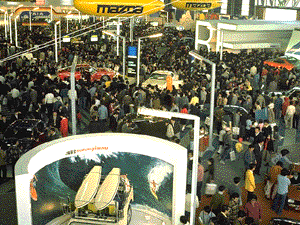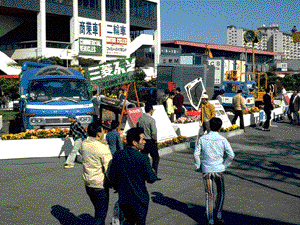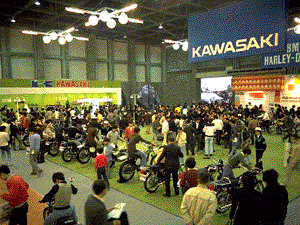 |
 |
 |
The
21st Tokyo Motor Show (1975
. 10/31 - 11/10)
 |
 |
| The 21st Tokyo Motor Show Poster |
- Life on Wheels -
JMIF put up "Life on Wheels" as the theme for the 21st
Motor Show, held two years after the 20th. Vehicles usefulness
to society should have been appealed straightforwardly,
but that seemed a little too strong t the time, so softer
expression was chosen. The theme could be regarded as
expressing the auto industry's commitment to coping with
the social environment and times. At the Tokyo Motor Show,
there had originally been provided common places for PR,
called PR Corner and PR Hall. One reason for this was
to review the vehicle and the industry from the standpoint
of the times.Another purpose was to display the industry
s wish for understanding, and to get feedback from the
audience. However, the audience tended to quickly pass
the place, and it was found ineffective.
Accordingly, it was decided for the reopening to clearly
impress the audience with the show s aim by putting up
the theme and making the Theme Hall independent but related,
with the title "Vehicles, Life and Us."
|
 |
 |
 |
Based on this plan, the 21st show was developed with emphasis on the following two points: (1) Introduction of the auto industry s broad and vital bearing on each individual s life as well as on the Japanese economy; (2) Introduction of technological endeavors such as anti-pollution technology and research of safety measures.
In the Theme Hall, various types of displays were made to show the broad connection of daily life and vehicles; relations between vehicles as an export industry and national economy; and the various facets of the auto industry contributing to acquisition of foreign currencies. For example, the working off oods delivery vehicles and refuse disposal vehicles was illustrated and described in simple terms. A very rare presentation was also seen under the title of "Man and Vehicles." This was an exhibition of the following old vehicles and motorcycles: 1918 "Detroit" electric vehicle (presented by Japan Storage Battery Co.), the 1961 Crown RS30 taxi (Toyota), the 1938 Nissan 12TS80bus (Nissan), The 1929 Sumida bus (Isuzu), the 1924 Ahrens-Fox fire engine (Tokyo Fire Defense Agency), a motorcycle for Antarctic expedition (Suzuki), a motorcycle for cow-herding (Kawasaki KV100), a motorcycle for police work (Yamaha YB125-E), and a sidecar for the Imperial Guard (Honda). Those five vehicles and four motorcycles interested the visitors by showing knowledge and ingenuity, and various relationships between life and vehicles in earlier days. The other main exhibition at this show was the opening to the public of anti-pollution technology. At that time every auto maker was giving its all to the development of anti-pollution technology. The makers already achieved the immediate objective of the 1975 regulations, and were just about to clear the 1976 regulations. Therefore, they exhibited their technological progress with successful products in each booth.
Toyota displayed TTC-C and TTC-V systems and also the Gas Turbine Century.Nissan exhibited the Steam Engine Cedric and showed its NAPS system using a multi-media show. Honda displayed its ESV with CVCC engine. Mitsubishi stressed high performance and low pollution by combining its Astro Engine and emission cleaning system MCA. Mazda displayed the rotary engine REAP and reciprocating engine CEAP system. Isuzu exhibited the Gemini Coupe which cleared the 1975 regulations by introducing GM technology for air injection EGRplus a catalytic converter. Fuji Heavy Industries announced the Leone Sports equipped with the SEEC-T system that cleared the 1976 regulation and attracted wide attention.
New models--hitherto the main attraction of the show --were very few, since every company put their strength in anti-pollution measures. The only new models displayed were the Toyota Corolla Sprinter Liftback, Silvia, and Cosmo s revival model. The rest of the exhibits had radical technological innovations under their hoods, but looked unchanged and mostly modest.
Prototypes for novelty s sake were gone. Prototypes on display were for seeking a new concept of a car. Among them was the Toyota Multi-purpose Wagon MP-1. This newly designed multi-purpose wagon, based not on a commercial vehicle but on a low-floor passenger car chassis, attracted attention as the forerunner of a future passenger car. The Nissan AD-1, 2-seater Sports with 1.4-liter mid-engine, was made with the conviction that an automobile has charm even in the harsh age of anti-pollution, fuel efficiency, and safety. It was conspicuous in the hall where an atmosphere of pollution control prevailed. There were 22 car makers and two motorcycle makers that participated from overseas. Although it was an international show, debuts were rare. What amused enthusiasts at the show were only the Renault 5TS, Peugeot 604 which had not been imported for some years and XJ-S Jaguar announced a short time ago. Participating foreign motorcycle makers were BMW and Harley. Few domestic models were displayed. Exhibitors were eager to present harmony with society by emphasizing in their displays safety and healthy pleasures of motorcycles.
In general, the attractions of the show lay not in new models but in the special schemes by the organizer around the theme of "Life on Wheels." One of those schemes was the "display of specially equipped vehicles." Forty vehicles that were not often seen on the streets were gathered together on a road in the showplace. The vehicle was shown working in various facets of life, such as garbage trucks, snow-removing vehicles, fresh fish carriers, and bathing vehicles. One unusual event was a "farmers market" held in the area. Fresh vegetables and fruits carried in by trucks were sold on during four days including Saturday and Sunday, as an example of the vehicle in life.
At the South Gate Area was "Family Bike Land." This let visitors experience the utility and pleasure of riding 50cc bikes, and guided them on basic techniques for safe riding. Another event was a tour of the Japan Automobile Research Institute. Still another was laying an automobile carrier alongside the Harumi Pier during six days of the show, with the cooperation of Honda, Nissan and Toyota to show the public the importance of the auto industry in exportation.
The 21st Show was thus aimed at the introduction of social functions of the automobile. Accordingly, and partly due to the shortening of the show period to 11 days, the number of visitors decreased to 981,400. It was the first time admissions were under 1 million since the the 9th Show.
|
 |
|
|
|